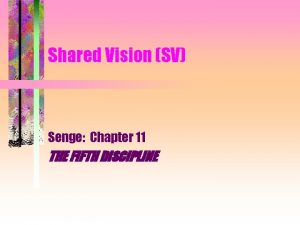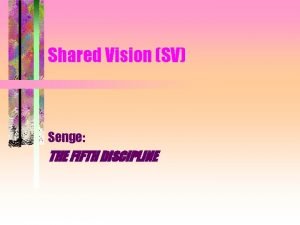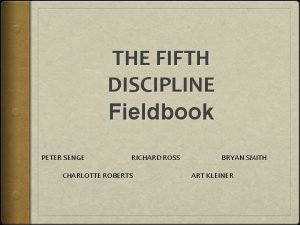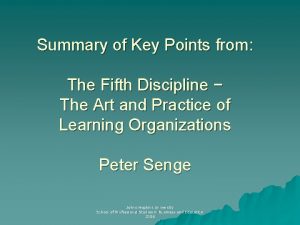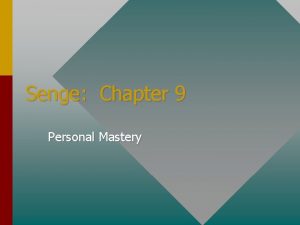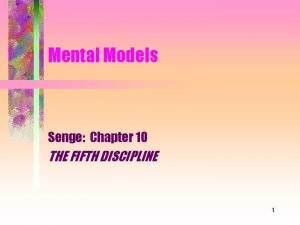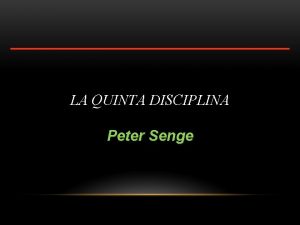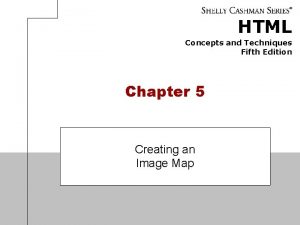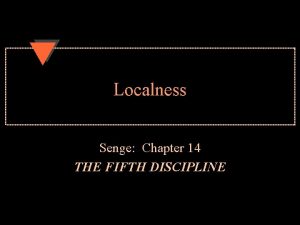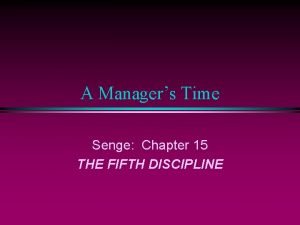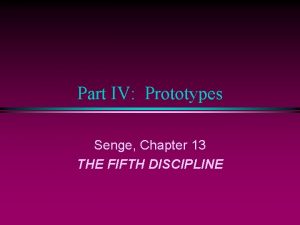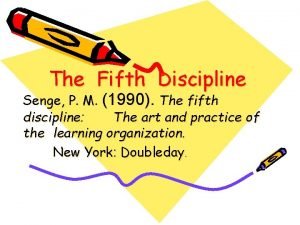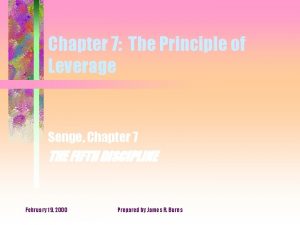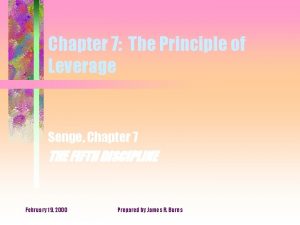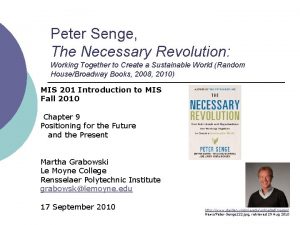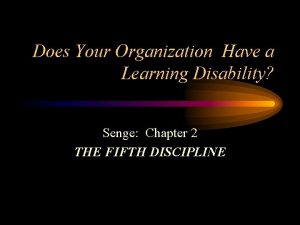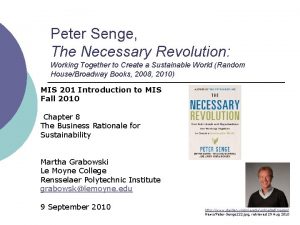Shared Vision SV Senge Chapter 11 THE FIFTH



























- Slides: 27

Shared Vision (SV) Senge: Chapter 11 THE FIFTH DISCIPLINE

Introduction • SV is the answer to the question “What do we want to create? ” • SV creates commitment, connectedness to those who hold it • Provides the focus and energy for learning • SV is subscribed to because it reflects the holder’s personal vision

Why Shared Visions Matter • Visionaries like Henry Ford, Steve Jobs, Theodore Vail, Kennedy were able to articulate their visions in ways that galvanized people to join with them • SV uplifts people’s aspirations – Making the motorcar affordable by everyone – Accelerating learning through use of PC’s – Bringing the world into communication through telecommunication – Leaving footsteps on the Moon – Making the world accessible through travel

Why else do Shared Visions Matter • SVs are exhilarating, exciting, galvanizing • Allows people who mistrusted each other to work together • High-performing teams have a strong sense of shared vision and purpose according to Abraham Maslov • SVs compel courage--doing whatever is needed in pursuit of the vision • Learning organizations do not exist without SV

Learning Organizations and SV • Vision establishes the overarching goal • SV compels new ways of thinking and acting • SV provides a rudder for keeping the learning process on course

SV fosters risk-taking and experimentation • “You know what needs to be done, but you don’t know how to do it” • You are willing to experiment

SV fosters a long-term view • Japanese believe building a great organization is like growing a tree – It takes 25 to 50 years • Parents of young children try to lay a foundation of values and attitude that will serve an adult 20 years hence • Strategic planning tends to reflect more of the “short-term” than “long-term” – Corporate leaders are more immersed in the problems of today than the opportunities of tomorrow

The Discipline of Building SV • SV emerges from personal visions • People with a strong sense of personal direction can join together to create a powerful synergy toward what I/we truly want • PM is the bedrock for developing shared visions

Building Shared Visions, Continued • We can’t force people to develop personal visions • We can create a climate that encourages personal vision Prepared by James R. Burns

We have to believe • We can create a differentiated B-school and one that is highly respected • We can lead with the best ideas, the best curriculum, the best faculty, etc. . • We have to articulate our vision for being the best--what else is there? • Vision does not have to derive from the highest levels of the organization

What about top-down vision • doesn’t need to be communicated in a dictatorial hierarchical • Top management goes off to write its vision statement with the help of consultants • What comes back is disappointing, often a one-shot vision • Management assumes they have now discharged their visionary duties

Writing vision statements • Rarely makes a vision “come alive” within an organization • Does not build on people’s personal visions • The new official vision fails to foster energy and commitment or passion • Even among the top-management team who created it • Vision is not a solution to a problem

The Annual Planning Ritual • Creative strategies seldom emerge • Fail to nurture genuine vision • Sometimes shared visions just bubble up from nowhere

For leaders to build shared visions…. • Must be willing to continually articulate their personal visions • Must be willing to ask “Will you follow me? ”

DEC’s vision to become electronically integrated • networks would tie together all of the functions (areas) • The process of building shared vision is not always glamorous • A visionary leader is not one who gives inspiring speeches • He is one who uses is vision to make decisions every day

Shared visions emerge. . . • as a result of the interactions of individual visions • individuals feel free to express their dreams • individuals will listen to the dreams of other team members • Multiple visions must be allowed to coexist • Diversity of ideas is welcomed

Spreading Visions: Enrollment, Commitment and Compliance • Commitment is close to the heart of contemporary managers • 90% of the time what passes for commitment is compliance • talk of getting subordinates to “buy into” the vision

Attitudes toward a vision • • Commitment Enrollment Genuine compliance Formal compliance Grudging compliance Non-compliance Apathy

Guidelines for Enrollment and Commitment • Be enrolled yourself • Be on the level • Describe the vision as simply and honestly as you can • Let the other person choose • Your efforts to convince the other person will be seen as manipulative • Ultimately, there is nothing you can do to get another person to enroll or commit

Anchoring Vision in a Set of Governing Ideas • The vision must be consistent with the governing ideas • Governing ideas, answer the critical questions” “What? ” “Why? ” “How? ” • Vision is the “What? ”--the picture of the future we seek to create • Purpose or mission is the “Why? ”--the organization’s answer to the question “Why do we exist? ”

Anchoring Vision, Cont’d • Core values answer the question “How do we want to act, consistent with our mission, along the path toward achieving our vision? ” • An org’s values might include integrity, openness, honesty, freedom, equal opportunity, leanness, merit or loyalty • ALL THREE GOVERNING IDEAS ANSWER THE QUESTION “What do we believe in? ”

Relationships between Purpose, Vision, and Values • Visions make the purpose (mission) more concrete and tangible • Core values are necessary to help people with day-to-day decision making • Purpose is abstract, vision is long term • But core values must be translatable into concrete behaviors

Positive Vs. Negative Vision • “What do we want” is different from “What do we want to avoid? ” • Negative visions are limiting because – negative energy is less motivating – carry a subtle message of powerlessness – they are inevitably short term • Org’s can be motivated by fear or by aspiration

Creative Tension and Commitment to the Truth • The most effective people are those who can hold their vision while remaining committed to seeing current reality clearly (the truth)

Shared Vision and the Fifth Discipline

The Missing Synergy: Shared Vision and Systems Thinking

Copyright C 2000 by James R. Burns • All rights reserved world-wide. CLEAR Project Steering Committee members have a right to use these slides in their presentations. However, they do not have the right to remove this copyright or to remove the “prepared by…. ” footnote that appears at the bottom of each slide. Prepared by James R. Burns
 Senge shared vision
Senge shared vision Senge shared vision
Senge shared vision Peter senge 1990 the fifth discipline
Peter senge 1990 the fifth discipline The fifth discipline summary
The fifth discipline summary Shared vision example
Shared vision example Personal mastery senge
Personal mastery senge Mental models senge
Mental models senge La quinta disciplina
La quinta disciplina Team learning senge
Team learning senge Bariatri senge
Bariatri senge Aprendizaje individual
Aprendizaje individual La quinta disciplina
La quinta disciplina 2 peter 3
2 peter 3 The illusion of taking charge examples
The illusion of taking charge examples Peter m. senge aportaciones a la calidad
Peter m. senge aportaciones a la calidad Fifth chapter menu
Fifth chapter menu Structured light
Structured light Hát kết hợp bộ gõ cơ thể
Hát kết hợp bộ gõ cơ thể Frameset trong html5
Frameset trong html5 Bổ thể
Bổ thể Tỉ lệ cơ thể trẻ em
Tỉ lệ cơ thể trẻ em Voi kéo gỗ như thế nào
Voi kéo gỗ như thế nào Tư thế worm breton là gì
Tư thế worm breton là gì Bài hát chúa yêu trần thế alleluia
Bài hát chúa yêu trần thế alleluia Kể tên các môn thể thao
Kể tên các môn thể thao Thế nào là hệ số cao nhất
Thế nào là hệ số cao nhất Các châu lục và đại dương trên thế giới
Các châu lục và đại dương trên thế giới Cong thức tính động năng
Cong thức tính động năng
